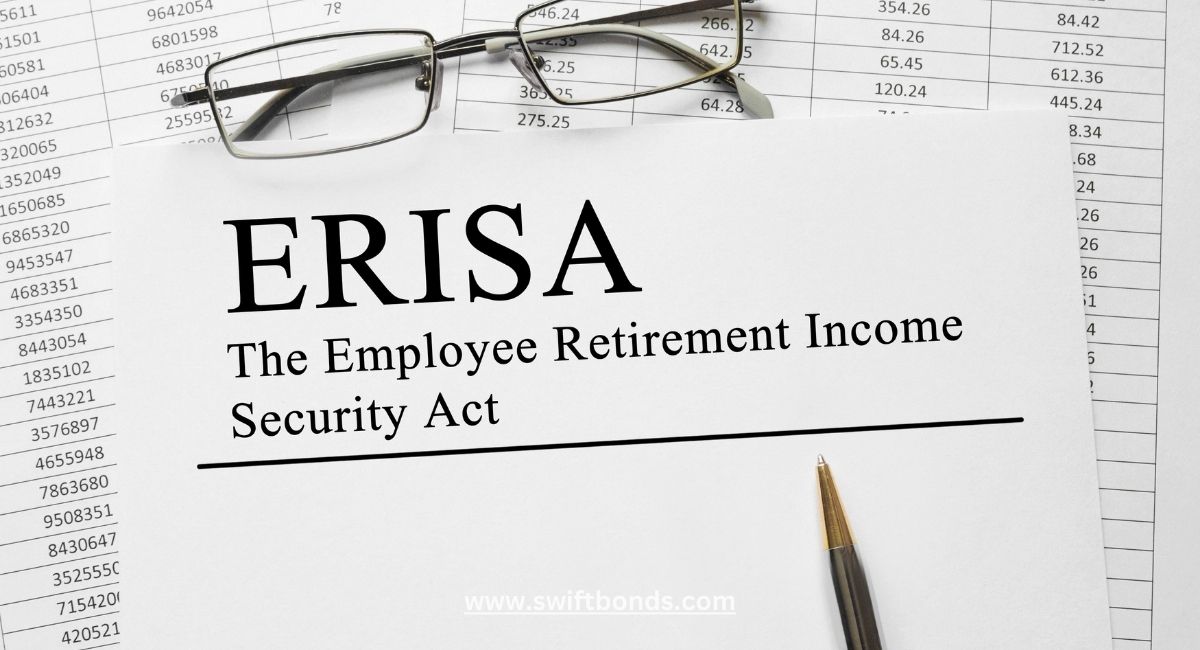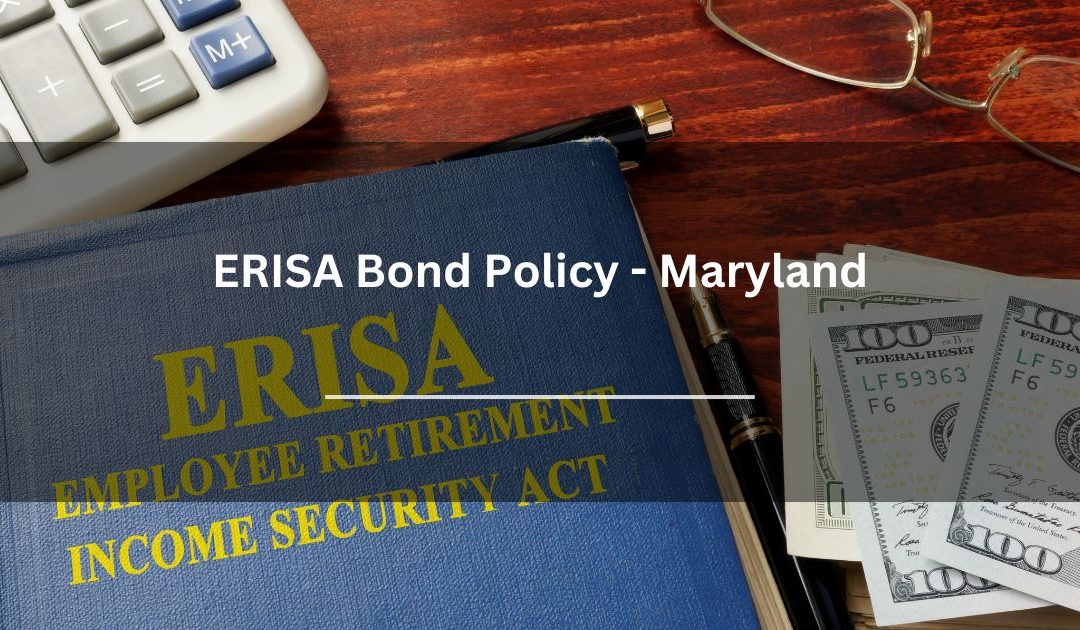Get an Instant Quote on ERISA Bond Policy
Introduction
From our perspective, managing employee benefit plans involves significant responsibility. Employers and fiduciaries in Maryland overseeing these plans must comply with federal regulations to safeguard employees’ assets. The ERISA Bond Policy – Maryland serves as a safety net, ensuring that those entrusted with managing employee benefit plans adhere to their fiduciary duties and prevent any financial mismanagement.
This bond, mandated by the Employee Retirement Income Security Act of 1974 (ERISA), protects plan participants by guaranteeing that fiduciaries handle plan funds responsibly. Similar to the Town of Easton, MD – Demolition Permit ($2,500) Bond, which ensures compliance with local demolition regulations, the ERISA bond protects beneficiaries from potential financial loss.

Misunderstandings Surrounding ERISA Bonds
We’ve noticed that many fiduciaries and plan administrators misunderstand the requirements and scope of the ERISA Bond Policy – Maryland. Some assume that regular insurance policies provide sufficient protection, overlooking the specific legal mandate for an ERISA bond. Others mistakenly believe that only larger benefit plans require bonding, unaware that even small plans are subject to ERISA bonding requirements.
Misunderstandings like these can expose employers and fiduciaries to legal penalties and financial liabilities. Similar confusion often arises around the Maryland – Sewage Sludge Utilization Performance Bond, where applicants may misunderstand their compliance obligations for managing waste and environmental impact.
Swiftbonds: Guiding Employers Through Compliance
Based on our experience, Swiftbonds has helped numerous employers and fiduciaries comply with ERISA bonding requirements. Swiftbonds simplifies the process by ensuring that the bond meets federal standards and covers the required percentage of plan assets. Just as Swiftbonds assists contractors with securing the Town of Easton, MD – Demolition Permit ($2,500) Bond, it offers expert guidance to fiduciaries managing employee benefit plans.

Steps to Secure an ERISA Bond in Maryland
What we’ve discovered is that obtaining an ERISA Bond Policy – Maryland involves a clear sequence of steps to ensure compliance with federal regulations:
-
Assess Plan Assets – Evaluate the total value of the assets managed by the plan to determine the required bond amount.
-
Select a Reliable Surety Provider – Choose a surety company like Swiftbonds that meets ERISA’s definition of an authorized provider.
-
Complete the Application Process – Submit information about the plan, fiduciaries, and asset values to the surety provider.
-
Purchase the Bond – Pay the bond premium, which typically corresponds to a small percentage of the required bond amount.
-
Maintain Bond Coverage – Renew the bond annually and adjust coverage as plan assets grow.
Swiftbonds assists fiduciaries in meeting each requirement, ensuring compliance and minimizing risk.
Consequences of Failing to Obtain an ERISA Bond
In our observation, failing to secure an ERISA Bond Policy – Maryland can have severe consequences for employers and fiduciaries. Without the proper bond in place, fiduciaries may face civil penalties, legal action, and personal liability for losses suffered by plan participants.
Non-compliance can also lead to fines imposed by the U.S. Department of Labor (DOL), jeopardizing the financial stability of the organization. Just as neglecting the requirements for a Maryland – Sewage Sludge Utilization Performance Bond can result in environmental and regulatory penalties, ignoring ERISA bonding obligations exposes fiduciaries to unnecessary risks.

Benefits of an ERISA Bond Policy in Maryland
We’ve learned that securing an ERISA Bond Policy – Maryland offers multiple advantages for employers, fiduciaries, and plan participants:
-
Regulatory Compliance – Demonstrates adherence to federal bonding requirements under ERISA.
-
Protection for Plan Assets – Safeguards employees’ retirement and welfare plan funds from mismanagement or dishonesty.
-
Reduced Fiduciary Risk – Mitigates the personal liability of fiduciaries in case of financial loss due to fraud or improper handling of plan assets.
These benefits mirror those provided by the Town of Easton, MD – Demolition Permit ($2,500) Bond, which ensures compliance with demolition regulations and protects public safety.
Compliance with Maryland’s Bonding Regulations and ERISA Requirements
Maryland follows federal ERISA regulations, requiring fiduciaries who manage employee benefit plans to obtain adequate bond coverage. The bond must cover at least 10% of the plan’s assets, up to a maximum of $500,000. However, for plans holding non-qualifying assets, such as real estate, the required bond amount may be higher.
The U.S. Department of Labor (DOL) enforces ERISA bonding requirements, ensuring that fiduciaries protect plan participants from financial loss. Similar to the Maryland – Sewage Sludge Utilization Performance Bond, which guarantees compliance with waste management regulations, an ERISA bond protects employees’ financial interests by holding fiduciaries accountable.

Conclusion
We’ve come to appreciate that securing an ERISA Bond Policy – Maryland is a fundamental step for fiduciaries managing employee benefit plans. This bond not only meets federal compliance standards but also protects plan participants from financial loss and ensures that fiduciaries fulfill their legal obligations.
Swiftbonds provides expert guidance throughout the bonding process, assisting fiduciaries in meeting all regulatory requirements. Whether obtaining an ERISA Bond Policy – Maryland or a Town of Easton, MD – Demolition Permit ($2,500) Bond, Swiftbonds offers reliable solutions to protect public interests and ensure compliance.
Frequently Asked Questions
Who is required to obtain this bond?
All fiduciaries managing employee benefit plans covered by ERISA must secure a bond. This includes plan administrators, trustees, and anyone handling plan assets.
How much coverage does an ERISA Bond require?
ERISA requires that the bond amount equal at least 10% of the plan’s assets, with a maximum coverage of $500,000. For plans holding non-qualifying assets, higher bond amounts may be required.
What happens if a fiduciary fails to obtain an ERISA Bond?
Failure to secure an ERISA bond can result in civil penalties, personal liability for plan losses, and enforcement actions by the U.S. Department of Labor.
How long does an ERISA Bond remain in effect?
ERISA bonds typically remain valid for one year and must be renewed annually. Fiduciaries should adjust bond amounts as plan assets grow.
Can any surety company issue an ERISA Bond?
No, the bond must be issued by a surety provider authorized by the U.S. Department of the Treasury. Swiftbonds meets these requirements and provides compliant ERISA bonds.


